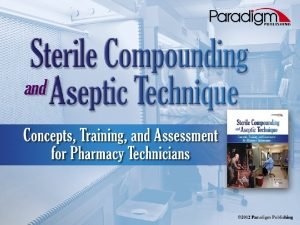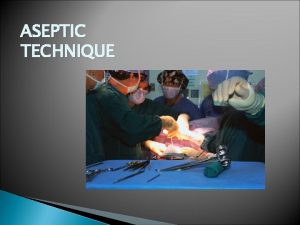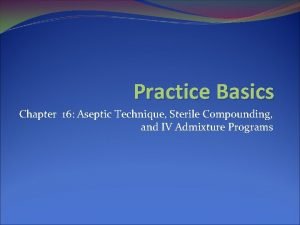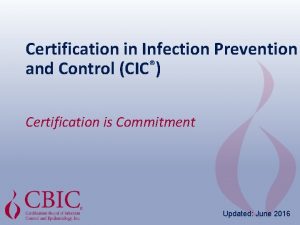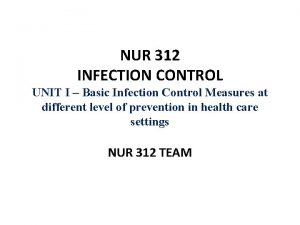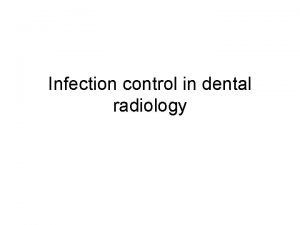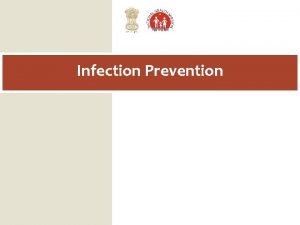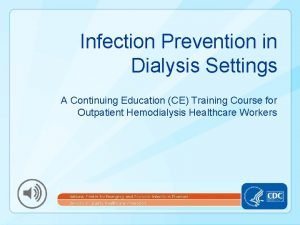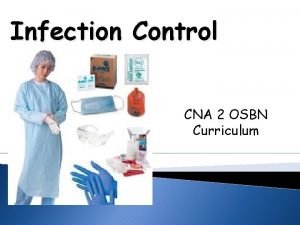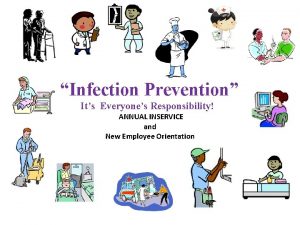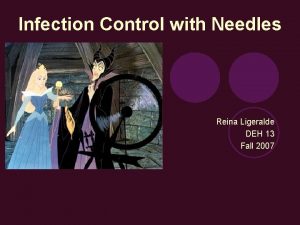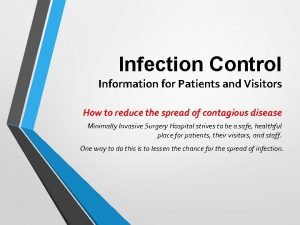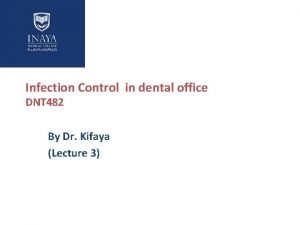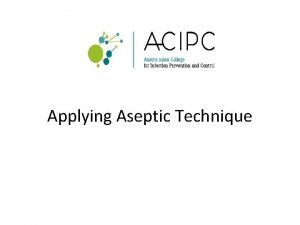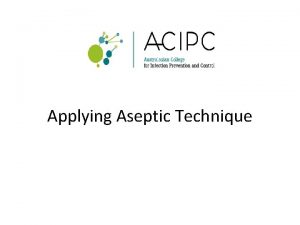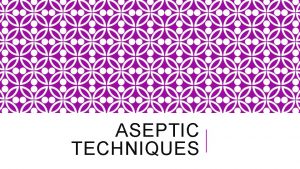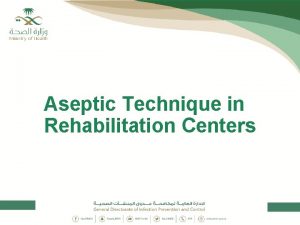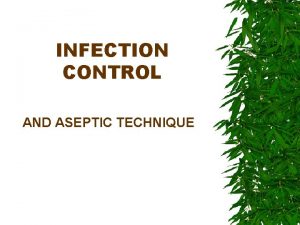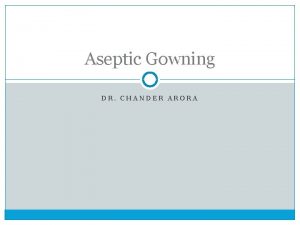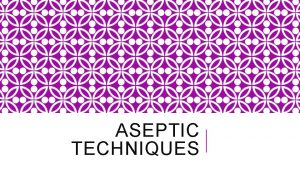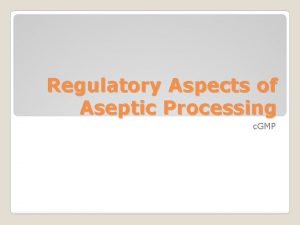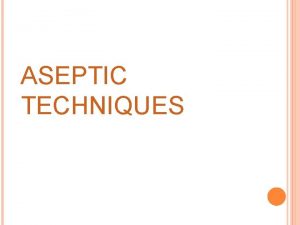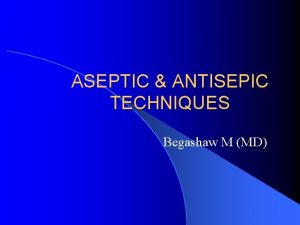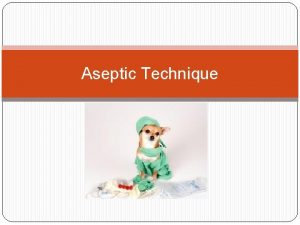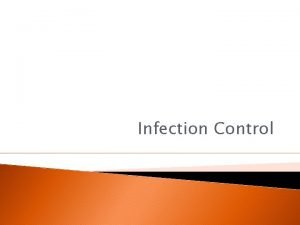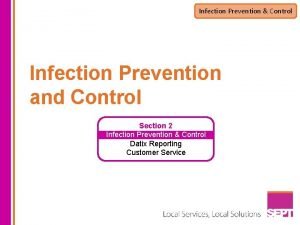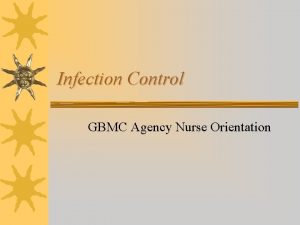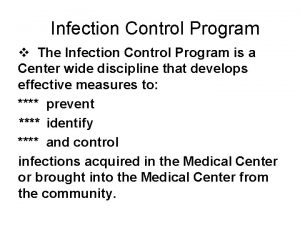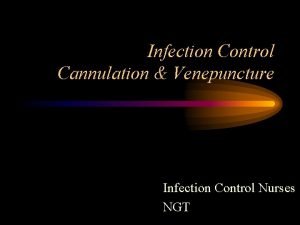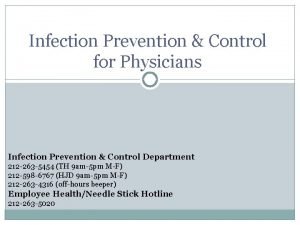Infection Control Aseptic NonTouch Technique Sally Aucken Catherine






















- Slides: 22

Infection Control & Aseptic Non-Touch Technique Sally Aucken & Catherine Jones 1

Learning Objectives Understand why critically ill pateints are vulnerable to infection Identify key principles infection control within a critical environment. Identify the key principles of Aseptic Non. Touch Technique (ANTT) Demonstrate knowledge of differences between standard and surgical ANTT

Infection Control WHY ARE CRITICALLY ILL PATIENTS MORE VULNERABLE TO INFECTION?

Infection Control: Vigilant bedspace decontamination between patients. (Soapy Wipes) Deep Clean Team for infected patients. Daily dampdusting. Personal Protective Equipment: Visors available at each bedspace. Gloves & Apron to be worn for any patient contact. Relatives to gel hands on entering unit & wear aprons at bedspace Full plastic gown for ‘dirtier’ procedures e. g. reaching over patient for roll.

Infection Control:

Infection Control: DAILY DAMPDUSTING IS MANDATORY

Catheter Care: Daily catheter care with soap & water Observe & document entry site daily Always hang the catheter bag below the level of the bladder Do not allow the catheter to come into contact with the floor Interruption of closed catheter circuit should only be undertaken with good clinical reason – Sterile gloves should be worn. Label catheter bag & change every 7 days

Failures in asepsis during aseptic technique observed in NHS Trusts (2006 -2010). Contamination of key-parts Poor cannulation site care Poor hand cleaning Each of these poor practices places the patient at high risk of infection. Poor aseptic field management Poor key-part cleaning Which do you always get right?

This presentation shows ANTT applied to IV therapy However, … ANTT can be applied to any aseptic technique You are now going to look at two ways in which safe ANTT can be taught and practiced. 1. By understanding the principles underpinning ANTT. 2. By learning the sequence of the IV ANTT guideline.

principle 1 The ANTT Theory & Practice Framework Principle 1 The main infection risk to the patient is the health care professional www. antt. org. uk enquiries@antt. org. uk

principle 2 The ANTT Theory & Practice Framework Principle 2 Health care workers must understand what asepsis is and how to establish and maintain it Sterile Free from micro-organisms Not achievable in typical health care settings. www. antt. org. uk enquiries@antt. org. uk Asepsis Free from pathogenic organisms. Achievable in typical health care settings. Clean An important action in removing dirt to help achieve asepsis. But not a satisfactory standard in itself for invasive procedures.

principle 3 The ANTT Theory & Practice Framework Principle 3 Identifying and protecting key-parts and key-sites is paramount Key-sites are open wounds, including insertion and puncture sites. Key-parts are the parts of the procedure equipment that come into direct or indirect contact with any liquid infusion or key-sites and with any active key-parts connected to the patient. If contaminated they present a very high risk of infection to the patient. www. antt. org. uk enquiries@antt. org. uk

principle 4 The ANTT Theory & Practice Framework Principle 4 Clinical procedures must be risk-assessed to determine the level of aseptic technique required Risk assessment 1 To determine type of technique: ‘With Standard- ANTT, can I ensure aseptic key-parts only come into contact with other aseptic key-parts or key-sites’? Risk assessment 2 To determine sterile or non sterile gloves: ‘Can I perform this procedure without touching key-parts or key-sites directly? ’ www. antt. org. uk enquiries@antt. org. uk

principle 5 The ANTT Theory & Practice Framework Principle 5 Asepsis is maintained with either Standard or Surgical ANTT www. antt. org. uk enquiries@antt. org. uk

principle 6 The ANTT Theory & Practice Framework Principle 6 Aseptic fields are important. Standard and Surgical-ANTT require different aseptic field management. Standard ANTT General aseptic field (Doesn’t require to be managed critically*) Micro critical aseptic fields essential Surgical ANTT Critical aseptic field (Must be managed critically*) Micro critical aseptic fields desirable * Only sterilised and aseptic equipment can come into contact with the aseptic field. www. antt. org. uk enquiries@antt. org. uk

Standard-ANTT - aseptic field management www. antt. org. uk enquiries@antt. org. uk

Standard-ANTT - The general aseptic field does not require managing critically General aseptic field Micro critical aseptic fields (Essential) www. antt. org. uk enquiries@antt. org. uk

This is a typical confused aseptic field. A ‘sterile’ drape has been added on the basis the patient is immunosuppressed. Subsequently, the health care worker believes it ok to leave the key-parts unprotected. But rather than add an extra layer of safety, has this not introduced extra risk? Exposed key-parts www. antt. org. uk enquiries@antt. org. uk

principle 7 The ANTT Theory & Practice Framework Principle 7 Non-touch technique is the most important component of Surgical and Standard-ANTT in Standard-ANTT www. antt. org. uk enquiries@antt. org. uk NTT in Surgical-ANTT

principle 8 The ANTT Theory & Practice Framework Principle 8 Appropriate infective precautions help promote and ensure asepsis www. antt. org. uk enquiries@antt. org. uk

principle 9 The ANTT Theory & Practice Framework Principle 9 Aseptic practice should be standardised www. antt. org. uk enquiries@antt. org. uk

principle 10 The ANTT Theory & Practice Framework Principle 10 Safe aseptic technique is reliant upon effective staff training in infection control, safe environments and fit for purpose equipment. (Board to ward support is key) www. antt. org. uk enquiries@antt. org. uk
 Sterile products and aseptic techniques
Sterile products and aseptic techniques Usp 797 gowning sequence
Usp 797 gowning sequence Aseptic hood
Aseptic hood Surgical conscience
Surgical conscience Non coring technique
Non coring technique Nsw health
Nsw health Dental radiography ppt
Dental radiography ppt What are universal precautions in cosmetology
What are universal precautions in cosmetology Chapter 16 infection prevention and control
Chapter 16 infection prevention and control Chapter 16 infection control and standard precautions
Chapter 16 infection control and standard precautions Chapter 15:8 using sterile techniques
Chapter 15:8 using sterile techniques Chapter 15 infection control
Chapter 15 infection control Cic certification
Cic certification Infection control definition
Infection control definition Infection control in dental radiology
Infection control in dental radiology Learning objectives for infection control
Learning objectives for infection control Infection control conclusion
Infection control conclusion Cna infection control
Cna infection control Cbic recertification
Cbic recertification Infection control is everyone's responsibility
Infection control is everyone's responsibility Infection control
Infection control Infection control information
Infection control information Root locus drawer
Root locus drawer

